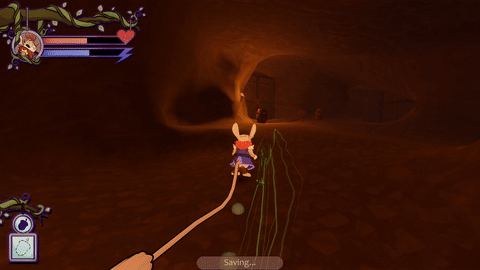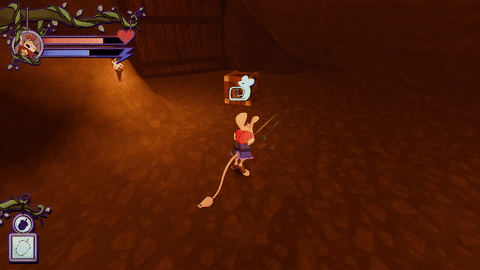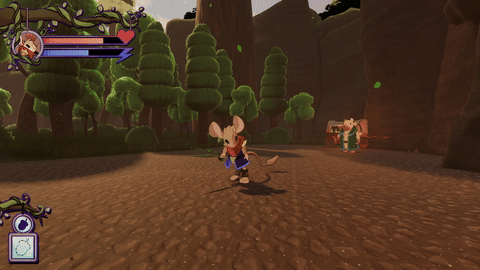Tales of Rodentia
Sept 2024 - April 2025 | Student Capstone Project

Tales of Rodentia is a stylized 3D platformer where players step into the paws of Bink, a former knight of the Rat Kingdom, on a quest to free the forest from the grip of a corrupted rat king. The game blends light combat, platforming, and storytelling in a vibrant, nature-inspired world.
I was the Level Designer on this project, responsible for the complete layout and gameplay flow of both levels. I also collaborated on core game design and worked on environmental art, co-creating the visual design for the first level and handling the entire environment design for the second level.
The game was built over eight months in Unity as part of our final-year capstone project, developed by a team of 11 over a 7 month time period.
Design Process
Level Design
Corrupted Forest
Overview
This was the introductory level in Tales of Rodentia, set in the Corrupted Forest. It serves as the player’s first real encounter with the world and its mechanics. The goal of the level is to guide the player toward the edge of the forest, culminating in a boss fight against the Owl Guardian, a corrupted protector who blocks the path to the kingdom's stronghold.
As the Level Designer, I created the layout, pacing, and gameplay flow to gradually introduce the game’s core systems. These include platforming, melee combat, and tail-based movement mechanics such as grappling and object interaction. The level is designed to teach players through exploration, combat scenarios, and visual cues, while maintaining a naturalistic environment that supports the story’s tone.
Reference & Inspiration
My approach to this level was rooted in both game analysis and real-world exploration. I wanted to create a forest that felt structured for gameplay but still retained a natural, lived-in feel.
I drew direct inspiration from Ghost of a Tale, not just for its rodent-based characters and environmental tone, but for how it balances whimsy and tension in its world design. For overall layout and forest structure, I studied the Faron Woods areas from The Legend of Zelda: Twilight Princess and Skyward Sword, paying attention to how they guide players while maintaining an organic flow.
To reinforce the level’s linear structure and pacing, I analyzed the level design of the original God of War on PS2. I referenced full-game walkthroughs and map breakdowns to understand how it managed progression, gated challenges, and vertical transitions while maintaining forward momentum.



Design & Block Out
The design process for this level began with a top-down sketch to explore flow and key encounter placement. Once the layout felt solid, I recreated it in Illustrator to refine the proportions, shape language, and paths more precisely.
With the 2D layout locked in, I moved into 3D, creating a greybox version of the level in a modeling program and importing it into Unity. This gave the team a playable version of the space early on and allowed us to test navigation, pacing, and enemy placement.
Initial feedback on the design was strong, but one key issue came up: the intro section needed more tutorialization. To address this, I added a new area to the beginning of the level focused on safely teaching the player core mechanics like jumping, swinging, and grappling, all before they reached more demanding sections.
This extra space helped smooth out the onboarding experience and improved player retention during testing. The final layout maintained its original vision but benefited from targeted iteration, giving players more time to internalize mechanics in a controlled environment before the action ramps up.
Pacing & Intensity
The level follows a linear structure with deliberate pacing that alternates between combat, traversal, and rest. Early sections focus on onboarding core mechanics, while later areas escalate in difficulty through enemy variety and environmental hazards.
Key gameplay beats include:
-
A tutorial space followed by the first enemy encounters
-
A mid-level mini-boss that unlocks the player’s primary weapon
-
A puzzle-based cave section with branching paths
-
A final climb in intensity leading to the Owl boss fight
Flow was guided using lighting, enemy placement, and terrain layout to naturally lead players through the environment while keeping the experience smooth and readable. Below is the intensity graph used for documentation.

Reflection
I'm proud of how the level came together in both design and execution. Players were able to navigate it smoothly and enjoyed the overall pacing. I'm especially proud of the cave section, which offered a sense of exploration within an otherwise linear structure. It provided multiple paths and created a natural break in intensity that added depth to the experience.
One of the bigger challenges was tuning the final platforming section. Early tests showed it was too difficult and frustrated players. After several iterations, the solution was to break it up by adding mid-point platforms, which made the section more readable and rewarding without losing its challenge.
This project taught me how to structure my level design workflow more efficiently, starting with sketches, moving into greyboxing, gathering feedback, and refining based on how players actually interact with the space.
Game Design
Alongside level design, I contributed to the core gameplay mechanics that define Tales of Rodentia. I helped conceptualize and develop two of the game’s main systems: the tail mechanic and the changing sword system.
When designing around a mouse protagonist, one of the most exciting challenges was finding ways to tie mechanics to the character’s form. The tail became a natural extension of the character — both visually and mechanically. I pitched and helped design the tail as a multi-purpose tool:
-
A grappling hook for traversal, allowing the player to swing between tree branches and cross gaps
-
A combat tool for pulling enemies closer or grabbing objects
-
A puzzle element, enabling players to move items around the environment
We wanted a system that encouraged movement and player expression, while still feeling grounded in the world and character.
To add variety and depth to combat, I also contributed to the design of the changing sword mechanic. The player can switch between multiple weapon forms — each with different attack styles and stamina costs. To avoid constant switching and keep combat meaningful, we implemented a stamina system that recharges through combat engagement. This created a rhythm where players are rewarded for staying aggressive and learning when to commit to weapon changes.
Both systems were designed to reinforce the game’s theme, expand player choice, and keep encounters dynamic without overwhelming new players.




